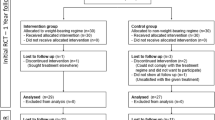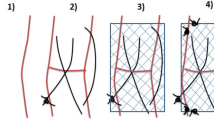Abstract
Background
This study aimed to describe the clinical, radiological, biomechanical, electromyographic, and histoenzymologic modifications in the “Gastrocnemius–Achilles Tendon–Calcaneus complex” caused by percutaneous Achilles tendon lengthening (PATL) versus Vulpius Achilles tendon lengthening (VATL) in New Zealand White (NZW) rabbits.
Materials and Methods
Eight female NZW rabbits were used at 7 months of age. Two rabbits were euthanized before surgery for anatomical dissection, three underwent PATL (two bilateral and one unilateral), and the three others underwent VATL (two bilateral and one unilateral). Clinical examination, biomechanics, electromyography, standard radiographs and magnetic resonance imaging (MRI), and histology and histoenzymology were assessed after surgery.
Results
At the end of the experiment, the subjects showed good clinical status but different functional outcomes of surgery: rabbits submitted to PATL developed permanent limp and lost their capacity to jump compared to rabbits submitted to VATL which remained able to ambulate and jump normally. Standard radiographs and MRI showed that PATL led to significantly greater increase in dorsal or anterior flexion of the tibiotarsal angle (TT angle) compared to VATL, whereas electromyographic and histoenzymologic observations of muscle unit showed little or no variation between the two groups of operated rabbits.
Conclusions
Although PATL leads to greater improvement in dorsal or anterior flexion (TT angle) of the rabbit ankle compared to VATL, it has negative effects on functional outcome as it reduces the contractile capacity of the rabbit muscle unit, ultimately impairing the ability to ambulate and jump.
Similar content being viewed by others
References
Ponseti IV, Smoley EN. Congenital clubfoot: The results of treatment. J Bone Joint Surg Am 1963;45:2261–70.
Ponseti IV. Congenital Clubfoot: Fundamentals of Treatment. Oxford: Oxford University Press; 1996.
Dobbs MB, Morcuende JA, Gurnett CA, Ponseti IV. Treatment of idiopathic clubfoot: An historical review. Iowa Orthop J 2000;20:59–64.
Nordin S, Aidura M, Razak S, Faishan WI. Controversies in congenital clubfoot: Literature review. J Med Sci 2002;9:34–40.
Staheli L. Clubfoot: Ponseti Management. Global HELP 2003–2016. 3rd ed. Berlin: Springer; 2009.
Canavese F, Mansour M, Moreau-Pernet G, Gorce Y, Dimeglio A. The hybrid method for the treatment of congenital talipes equinovarus: Preliminary results on 92 consecutive feet. J Pediatr Orthop B 2017;26:197–203.
Dimeglio A, Canavese F. The French functional physical therapy method for the treatment of congenital clubfoot. J Pediatr Orthop B 2012;21:28–39.
Richards BS, Faulks S, Rathjen KE, Karol LA, Johnston CE, Jones SA, et al. A comparison of two nonoperative methods of idiopathic clubfoot correction: The Ponseti method and the French functional (physiotherapy) method. J Bone Joint Surg Am 2008;90:2313–21.
Chotel F, Parot R, Seringe R, Berard J, Wicart P. Comparative study: Ponseti method versus French physiotherapy for initial treatment of idiopathic clubfoot deformity. J Pediatr Orthop 2011;31:320–5.
Bergerault F, Fournier J, Bonnard C. Idiopathic congenital clubfoot: Initial treatment. Orthop Traumatol Surg Res 2013;99:S150–9.
Vulpius O, Stoffel A. Orthopaedische Operationslebre. 2nd ed. Stuttgart: Ferdinad Enke; 1920.
Yngve DA, Chambers C. Vulpius and Z-lengthening. J Pediatr Orthop 1996;16:759–64.
Meier Bürgisser G, Calcagni M, Bachmann E, Fessel G, Snedeker JG, Giovanoli P, et al. Rabbit achilles tendon full transection model-wound healing, adhesion formation and biomechanics at 3, 6 and 12 weeks post-surgery. Biol Open 2016;5:1324–33.
MacNeille R, Hennrikus W, Stapinski B, Leonard G. A mini-open technique for Achilles tenotomy in infants with clubfoot. J Child Orthop 2016;10:19–23.
Doherty GP, Koike Y, Uhthoff HK, Lecompte M, Trudel G. Comparative anatomy of rabbit and human Achilles tendons with magnetic resonance and ultrasound imaging. Comp Med 2006;56:68–74.
Ippolito E, Natali PG, Postacchini F, Accinni L, De Martino C. Morphological, immunochemical, and biochemical study of rabbit Achilles tendon at various ages. J Bone Joint Surg Am 1980;62:583–98.
Trudel G, Koike Y, Ramachandran N, Doherty G, Dinh L, Lecompte M, et al. Mechanical alterations of rabbit Achilles’ tendon after immobilization correlate with bone mineral density but not with magnetic resonance or ultrasound imaging. Arch Phys Med Rehabil 2007;88:1720–6.
Kalmar B, Blanco G, Greensmith L. Determination of muscle fiber type in rodents. Curr Protoc Mouse Biol 2012;2:231–43.
Schweitzer ME, Karasick D. MR imaging of disorders of the Achilles tendon. AJR Am J Roentgenol 2000;175:613–25.
Pirani S, Zeznik L, Hodges D. Magnetic resonance imaging study of the congenital clubfoot treated with the Ponseti method. J Pediatr Orthop 2001;21:719–26.
Richards BS, Dempsey M. Magnetic resonance imaging of the congenital clubfoot treated with the French functional (physical therapy) method. J Pediatr Orthop 2007;27:214–9.
Barone R. Anatomie Comparée des Mammifères Domestiques. Tome I-VI. Paris: Vigot Frères Editeurs; 1999–2004.
Williams PL, Warwick R, Dyson M, Bannister LH. Gray’s Anatomy. 37th ed. London, UK: Longman Group UK Limited; 1989.
Kilkenny C, Browne WJ, Cuthill IC, Emerson M, Altman DG. Improving bioscience research reporting: The ARRIVE guidelines for reporting animal research. PLoS Biol 2010;8:e1000412.
Buschmann J, Müller A, Nicholls F, Achermann R, Bürgisser GM, Baumgartner W, et al. 2D motion analysis of rabbits after Achilles tendon rupture repair and histological analysis of extracted tendons: Can the number of animals be reduced by operating both hind legs simultaneously? Injury 2013;44:1302–8.
Turk C, Guney A, Halici M, Kafadar I, Oner M, Zumurut M. Results of repair of the acute Achilles tendon rupture through different methods (an experimental study). J Bone Joint Surg Br 2010;92 Suppl IV:591.
Author information
Authors and Affiliations
Corresponding author
Rights and permissions
About this article
Cite this article
Canavese, F., Barbetta, D., Canavese, B. et al. The “Gastrocnemius–Achilles Tendon–Calcaneus Complex”: Different Responses after Percutaneous versus Vulpius Achilles Tendon Lengthening in New Zealand White Rabbits. JOIO 53, 333–339 (2019). https://doi.org/10.4103/ortho.IJOrtho_397_17
Published:
Issue Date:
DOI: https://doi.org/10.4103/ortho.IJOrtho_397_17




